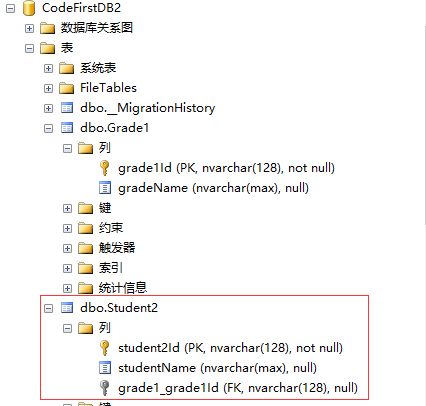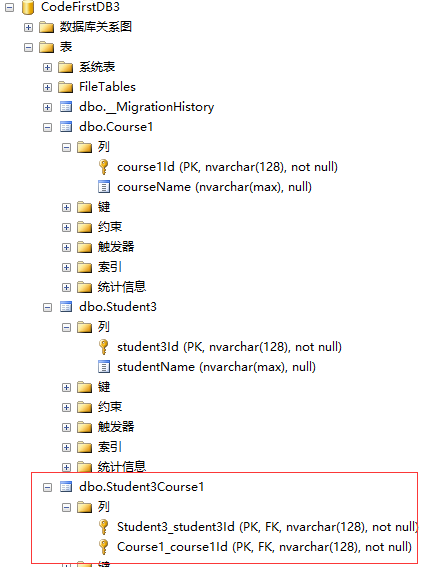一. 简介
1. 正宗的CodeFirst模式是不含有edmx模型,需要手动创建实体、创建EF上下文,然后生成通过代码来自动映射生成数据库。
2. 旨在:忘记SQL、忘记数据库。
3. 三类配置:One To One(one-to-zero-or-one)、One To Many、Many To Many。
注意:在该模块使用最简单的模式配置这三种关系,暂时先不考虑DataAnnotation和Fluent API
A. One To One(one-to-zero-or-one)
①:一个学生对应一个或零个地址,一个地址只能对应一个学生
②:实现方式:
a:Student表中添加StudentAddress属性,StudentAddress表中添加Student属性,然后给StudentAddress中的主键加上[ForeignKey("stu")] ,
特别注意stu代表Student属性的名字。
b:编写配置文件
发现的现象
a.已经生成了一次数据库,修改表结构,会报错:数据添加失败支持“dbContext1”上下文的模型已在数据库创建后发生更改。
请考虑使用 Code First 迁移更新数据库(http://go.microsoft.com/fwlink/?LinkId=238269)。
b. 类名+Id结尾属性自动生成主键。
c.生成的数据库默认保存在数据库的安装目录下。
d.在数据库中:StudentAddress中的studentAddressId既是主键,又是外键
B. One To Many
①:一个年级有多个学生,一个学生只能在一个年级
②:实现方式:
a:Student2表中添加Grade1属性,Grade1表中添加ICollection<Student2>属性
b:编写配置文件
发现的现象:
a. 数据库中:Student2表中,增加了一个新的字段grade1_grade1Id作为外键
C. Many To Many
①:一个学生有多门课,一门课有多个学生上
②:实现方式:
a:Student3表中添加ICollection<Course1>属性,Course1表中添加ICollection<Student3>属性
b:编写配置文件
发现的现象
a. 数据库中多了一张表:Student3Course1,里面有两个外键
二. 代码实战
1. One To One(one-to-zero-or-one)
1 /// <summary> 2 /// 学生表(一个学生只能有一个地址或没有地址) 3 /// </summary> 4 public class Student 5 { 6 public Student() 7 { 8 9 } 10 public string studentId { get; set; } 11 12 public string studentName { get; set; } 13 14 public virtual StudentAddress StudentAddress { get; set; } 15 } 16 /// <summary> 17 /// 学生地址表(一个地址只能对应一个学生) 18 /// </summary> 19 public class StudentAddress 20 { 21 public StudentAddress() 22 { 23 24 } 25 26 [ForeignKey("stu")] 27 //特别注意这个地方,stu对应下面的 Student stu; 28 //另外特别注意:studentAddressId,符合默认的Id生成规则,自动映射成主键,否则需要加【key】特性 29 public string studentAddressId { get; set; } 30 31 public string addressName { get; set; } 32 33 public virtual Student stu { get; set; } 34 }
1 public class dbContext1:DbContext 2 { 3 public dbContext1() 4 : base("name=dbContext1") 5 { 6 7 } 8 public DbSet<Student> Student { get; set; } 9 10 public DbSet<StudentAddress> StudentAddress { get; set; } 11 12 13 protected override void OnModelCreating(DbModelBuilder modelBuilder) 14 { 15 base.OnModelCreating(modelBuilder); 16 } 17 }
<!--正宗的CodeFirst OneToOne-->
<add name="dbContext1" connectionString="data source=localhost;initial catalog=CodeFirstDB1;persist security info=True;user id=sa;password=123456;MultipleActiveResultSets=True;App=EntityFramework" providerName="System.Data.SqlClient" />

2. One To Many
/// <summary> /// 年级表(一个年级有多个学生) /// </summary> public class Grade1 { public string grade1Id { get; set; } public string gradeName { get; set; } public virtual ICollection<Student2> student2 { get; set; } } /// <summary> /// 学生表(一个学生只能在一个年级) /// </summary> public class Student2 { public string student2Id { get; set; } public string studentName { get; set; } public virtual Grade1 grade1 { get; set; } }
public class dbContext2 : DbContext { public dbContext2() : base("name=dbContext2") { } public DbSet<Student2> Student2 { get; set; } public DbSet<Grade1> Grade1 { get; set; } protected override void OnModelCreating(DbModelBuilder modelBuilder) { base.OnModelCreating(modelBuilder); } }
<!--正宗的CodeFirst OneToMany--> <add name="dbContext2" connectionString="data source=localhost;initial catalog=CodeFirstDB2;persist security info=True;user id=sa;password=123456;MultipleActiveResultSets=True;App=EntityFramework" providerName="System.Data.SqlClient" />

3. Many To Many
/// <summary> /// 学生表(一个学生有多门课) /// </summary> public class Student3 { public string student3Id { get; set; } public string studentName { get; set; } public virtual ICollection<Course1> course { get; set; } } /// <summary> /// 课程表(一门课会有多个学生上) /// </summary> public class Course1 { public string course1Id { get; set; } public string courseName { get; set; } public virtual ICollection<Student3> student { get; set; } }
1 public class dbContext3 : DbContext 2 { 3 public dbContext3() 4 : base("name=dbContext3") 5 { 6 7 } 8 public DbSet<Student3> Student3 { get; set; } 9 10 public DbSet<Course1> Course1 { get; set; } 11 12 13 protected override void OnModelCreating(DbModelBuilder modelBuilder) 14 { 15 base.OnModelCreating(modelBuilder); 16 } 17 }
<!--正宗的CodeFirst OneToMany-->
<add name="dbContext3" connectionString="data source=localhost;initial catalog=CodeFirstDB3;persist security info=True;user id=sa;password=123456;MultipleActiveResultSets=True;App=EntityFramework" providerName="System.Data.SqlClient" />

三. 总结
上面的三种数据库表的对应关系主要都是采用的EF的默认协定,比如:
A: 类名+ID、类名+Id、类名+id自动生成主键(类名忽略大小写),
B: string类型自动映射成nvarchar(max)
但在实际开发中,默认协定显然不灵活,那么我们如何自定义配置呢(自定义主键、设置非空、设置类型、长度等),EF提供两种方式:DataAnnotations和Fluent API,但大多数情况都是两者配合使用,关于二者的详细使用,请见后面章节。
!
- 作 者 : Yaopengfei(姚鹏飞)
- 博客地址 : http://www.cnblogs.com/yaopengfei/
- 声 明1 : 本人才疏学浅,用郭德纲的话说“我是一个小学生”,如有错误,欢迎讨论,请勿谩骂^_^。
- 声 明2 : 原创博客请在转载时保留原文链接或在文章开头加上本人博客地址,否则保留追究法律责任的权利。